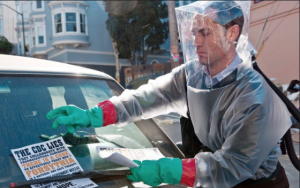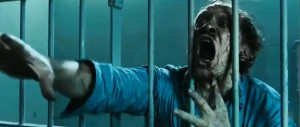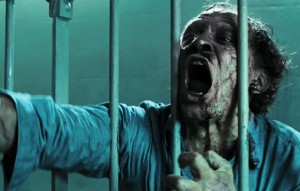“Stop touching your face, Dave.”: VIRAL MOVIES TO WATCH IN SELF-ISOLATION.
 “What we do know, is that in order to become sick you have to first come in contact with a sick person or something that they touched. In order to get scared, all you have to do is to come in contact with a rumor, or the television or the internet.”
“What we do know, is that in order to become sick you have to first come in contact with a sick person or something that they touched. In order to get scared, all you have to do is to come in contact with a rumor, or the television or the internet.”
Sound familiar? No, it’s not a ripped-from-the-headlines excerpt from a CDC speech. It’s a quote from “Contagion,” Steven Soderbergh’s 2011 all-star “Towering Inferno” of germ movies.
If “Jaws” kept people out of the water “Contagion” should have kept them from touching their faces. The average person touches their face upwards of 3,000 times a day, and in the world of “Contagion” everything that comes in contact with your skin — an elevator button, a glass at an airport, a handrail on a ferry — could be fatal. In our world of big diseases with little names like COVID-19, SARS and H1N1, germs are the new Frankensteins.
The movies have used microscopic germs and viruses as bogeymen for years, leaving us with a plethora of topical films to stream during quarantine and self-isolation.
“28 Days Later” begins with a great horror movie premise. A group of British activists free infected animals from their cages, unleashing a deadly “rage” virus on the human population. It is a full-blown Halloween flick, complete with drooling angry zombies, (although most of the horror here is psychological) but at its core it is also a compelling study of human nature and the will to survive.
“The Crazies,” a remake of a 1973 George A. Romero film, is the story of a virus that turns the inhabitants of a sleepy Norman Rockwell town into koo-koo bananas killers. It’s a classic tale of “us” versus “them”, with an extra “them” thrown in for good measure.
“Pontypool” is about a disease that turns regular people into flesh eating creeps, but it’s more about how they became that way than the eerie aftereffects of the sickness. Set entirely inside a small radio station in the basement of a church, the story focuses on announcer Grant Mazzy (Stephen McHattie), his producer Sydney (Lisa Houle) and call screener Laurel Ann (Georgina Reilly) who use eye witness accounts to slowly piece together the horrible story that is happening outside their doors. When the reports turn ominous Mazzy realizes he is at the center of a big story and keeps broadcasting. What he doesn’t realize is that, perhaps, he is helping to spread the disease.
“Pontypool” is a movie set in a radio station that plays like a radio show. By and large the action is described and for once the old cliché that what you can’t see is more terrifying that what you can actually see rings true. Couple that with a mounting sense of doom and you have an edge of your seat thriller.
“Outbreak” features germs of a less speculative type. Dustin Hoffman, Rene Russo and Morgan Freeman star in this 1995 film about an outbreak of a fictional Ebola virus called Motaba spread in the States by a white-headed capuchin monkey. If the contagious simian looks familiar, no wonder. It’s Betsy who also appeared as Ross’s pet Marcel on “Friends.” The sitcom spoofed Betsy’s work in the disaster flick by showing the monkey on a poster for a fictional film called “Outbreak 2: The Virus Takes Manhattan.”
Michael Crichton dreamt up the idea for “The Andromeda Strain” when he was still a medical student. The story of a deadly alien virus was inspired by a conversation with one of his teachers about the concept of crystal-based life-forms. His novel was a bestseller and the author — who would later go on to write the sci-fi classics “Westworld” and “Jurassic Park” — actually makes a cameo appearance in the hit 1971 film of the same name. He can be seen in the scene where the star of the movie, Dr. Hall (James Olson), is told to report to the government’s secret underground research facility to study an outbreak of a deadly extraterrestrial microorganism in Arizona.
More down to earth is “The Cassandra Crossing,” a big budget disease-on-a-train flick. This time it’s not an extra-terrestrial virus, but a plague contaminated terrorist starting all the trouble. Structured like a “Love Boat” episode, with an all-star cast that mixes and matches Sophia Loren with O.J. Simpson, it has none of “Andromeda’s” serious edge, but for sheer cheesy fun it can’t be beat.
Medical mayhem rules in “Warning Sign,” where an experimental virus turns people (including “Law and Order’s” Sam Waterston) into rage filled maniacs, a plot echoed in “Resident Evil” when a virus gets loose in a secret facility. “The T-virus is protean,” says the Red Queen, “changing from liquid to airborne to blood transmission, depending on its environment. It is almost impossible to kill.” “The Thaw” sees Val Kilmer unleash a prehistoric plague when he discovers a diseased Woolly Mammoth carcass. Eli Roth gave new meaning to the term cabin fever in his virus movie of the same name and the film “Doomsday” sees most of Scotland devastated by a deadly germ.
Predating all of them was “Panic in the Streets,” a low-budget film noir set in 1950s New Orleans. In it, a doctor and policeman (Richard Widmark and Paul Douglas) have just 48 hours to track down an illegal immigrant infected with pneumonic plague and stop a possible eruption of Black Death. Made during the Cold War, the rapid spread of the infection plays like a paranoid metaphor for the proliferation of Communist ideology. Despite this subtext, director Elia Kazan said: “This isn’t very deep. It has other virtues. It has lightness of foot, it has surprise, it has suspense, it’s engaging.”
These days watching the news can feel as though we’re watching a scene from one of these fictional bacteriological horror movies come to life. As alarmist as the films may be, they occasionally offer up some good, simple advice in the face of a pandemic: “Stop touching your face, Dave,” says Dr. Erin Mears in “Contagion.”



